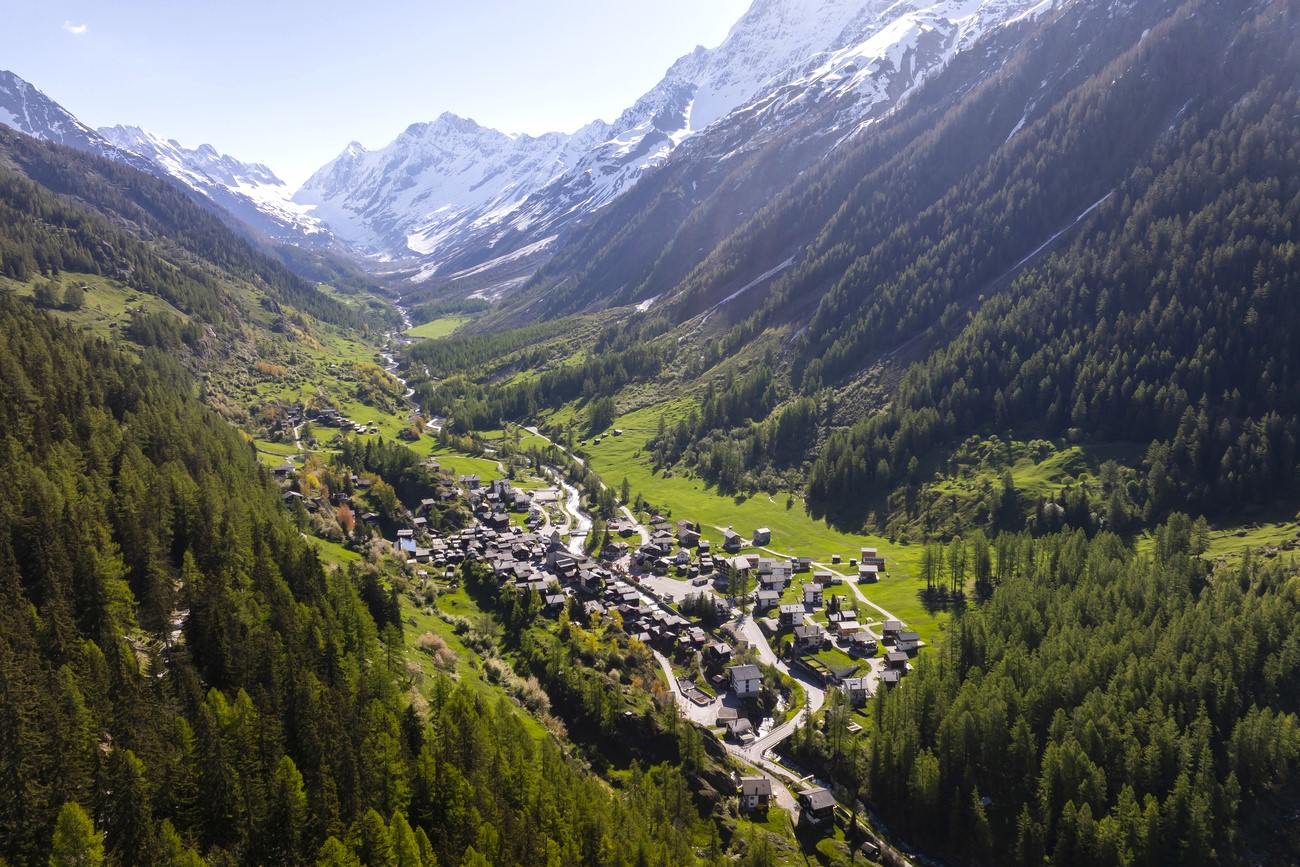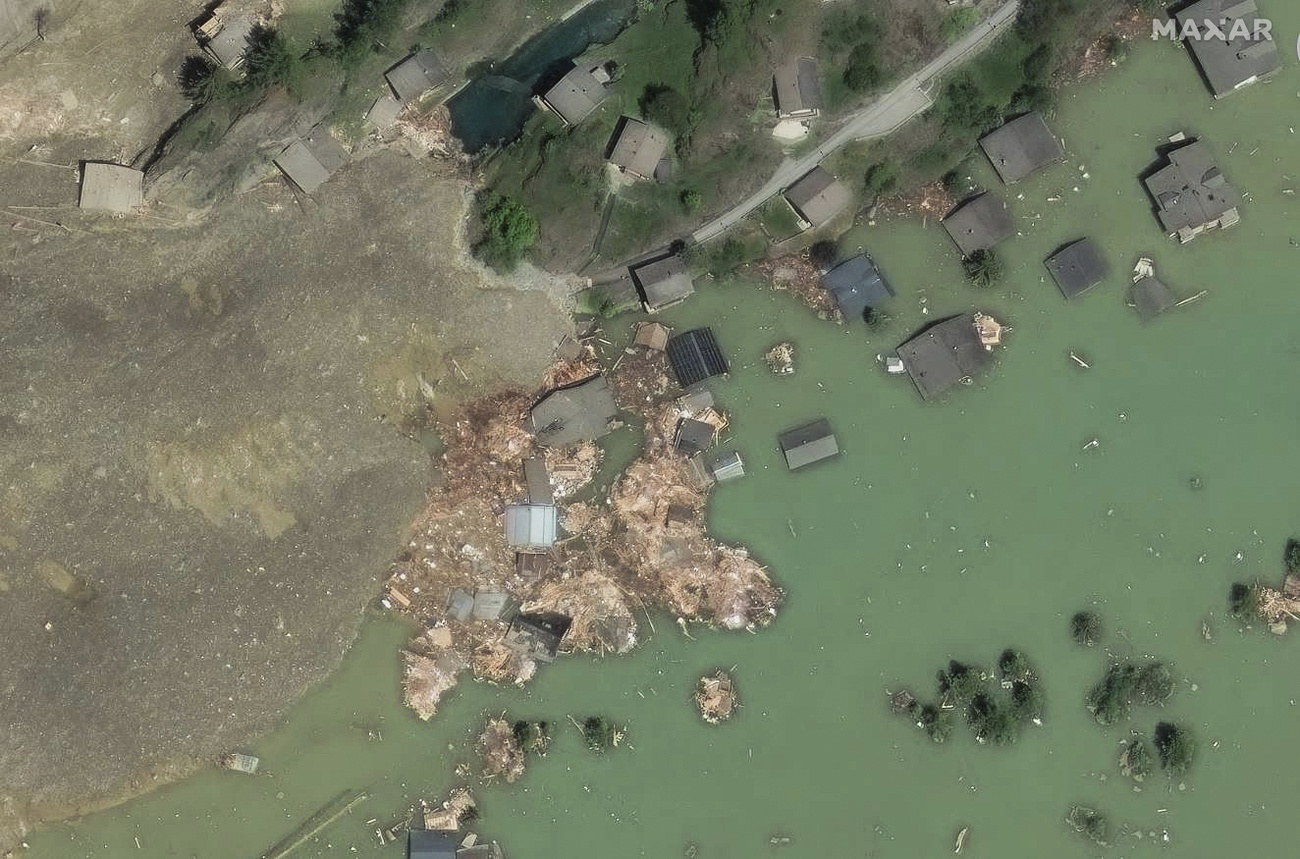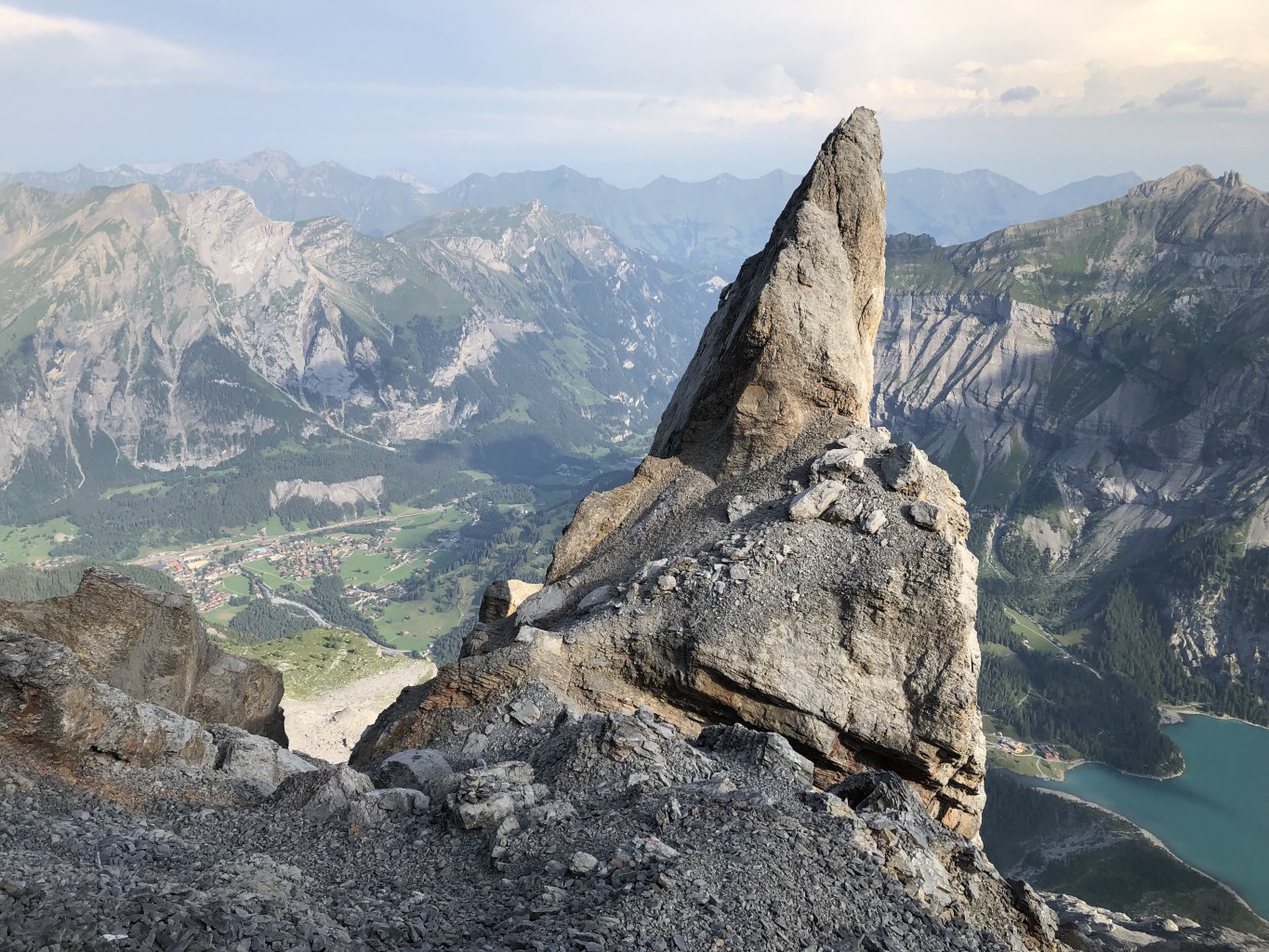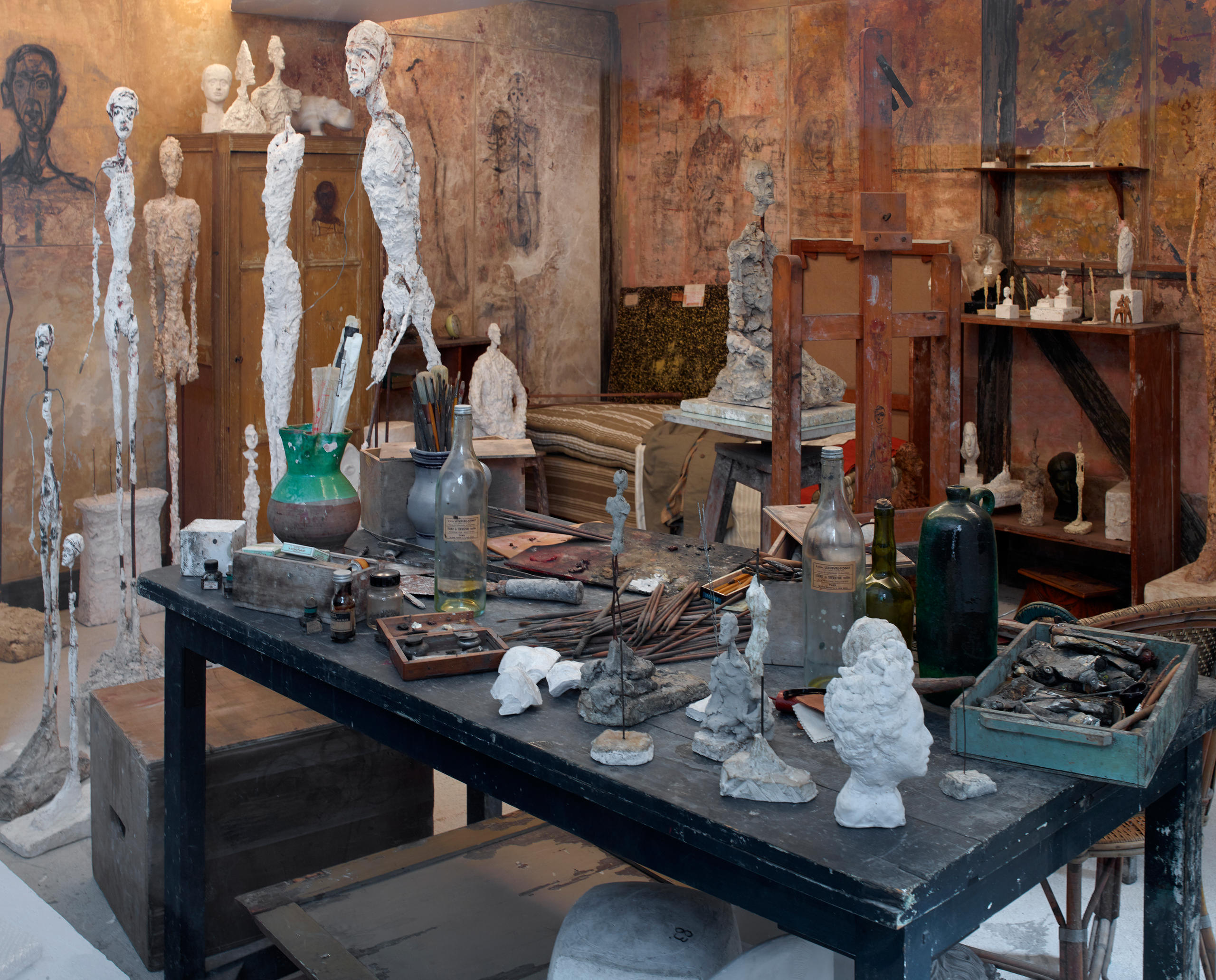
Why do Swiss mountains collapse? It’s complicated

Small landslides are on the rise in the Alps due to climate change, but it’s less obvious what is causing large-scale natural disasters such as the one that devastated the Swiss village of Blatten in canton Valais.
Bondo, Brienz, Lostallo, Cevio and now Blatten. The residents of these Swiss Alpine villages share a common fate: they have had to abandon their homes under threat of natural disasters. Landslides and debris flows are making places that have been inhabited for centuries unsafe for residents.
In Blatten, in the Lötschental valley in Valais, an estimated nine million cubic metres of ice, mud and rock crashed down a nearby mountain on May 28, wiping out the village. The few houses that remained intact were later flooded.
The village’s 300 residents had already been evacuated after part of the Kleines Nesthorn mountain above the glacier began to crumble. Around 4-6 million cubic metres of rocks had broken loose prior to huge collapse and piled up on the glacier below, dragging it down into the valley.
+ Landslide threat: authorities order evacuation of Swiss mountain village
“It was quite an unpredictable event,” Mylène Jacquemart, researcher in glaciology at the federal technology institute ETH Zurich and at the Federal Research Institute for Forest, Snow and Landscape (WSL), told SWI swissinfo.ch after the first rockfall. “The changes in the rock either happened very quickly or there had already been movement for months or years and no one noticed.”
Predicting such events presents researchers with a complex puzzle that involves understanding climate change as well as numerous other factors that can influence the movement of mountains.
>> Watch the collapse of the Birch Glacier above Blatten in southern Switzerland on May 28, 2025:
Climate change increases natural hazards
There have always been areas of instability in the Swiss Alps, says natural hazards expert Federico Ferrario. This is due to geological and hydrogeological conditions, as well as other weather effects.
“With climate change, these instabilities are becoming increasingly relevant even at high altitudes,” Ferrario says. Glaciers and permafrost – called the “glue” of the Alps – are melting as temperatures rise, destabilising slopes. The risk of collapse increases.
A recent studyExternal link by the WSL confirms that climate change is increasing the risk of natural disasters in the Alps. Rock falls and rock wall collapses may occur more frequently in Alpine regions with melting permafrost.
Switzerland is particularly affected by climate change, and the Alps are among the fastest-warming regions on the planet. The average temperature has risen by almost 3°C compared to pre-industrial levels, about twice the global average.
>> What is permafrost and why does its thawing threaten mountain regions? We explain it here:

More
How climate change is threatening permafrost’s delicate balance
Large landslides: exceptional or increasingly frequent?
However, the WSL’s analysis of scientific literature from the past 30 years shows there are still many uncertainties about the precise reasons for collapses in the mountains. An unequivocal link to climate warming exists only for rockfalls, where individual rocks with a diameter of less than 50 centimetres come off the mountains. (The differences between rockfalls, landslides and rock avalanches are explained hereExternal link.)
Quantifying the impact of climate change on landslides and other mass mountain movements remains difficult because of nature’s complexities as well as limits in available data and existing statistical processing techniques, the WSL points out.
For small landslides, on the order of 100 to 1,000 cubic metres of material, there is a clear link to climate change, says Mylène Jacquemart, coauthor of the WSL study. “They are happening more often, especially at high altitudes,” she says. Such landslides can block hiking trails, damage buildings and pose a risk to people and animals in their path.
But drawing a link between rising temperatures and larger landslides such as the current one in Blatten or Bondo’s 2017 event is premature, according to Jacquemart. “Our systematic observations extend over a period of about 20 years. It’s too little to say whether these are exceptional events or whether there is a statistically significant change,” she says.

Christophe Lambiel, a professor at the University of Lausanne and a specialist in permafrost and the evolution of Alpine landscapes, believes climate change accelerated the movement of the Birch Glacier above Blatten. When permafrost deteriorates, “the rock becomes unstable, blocks fall and weigh down the glacier, which accelerates along a steep slope,” he told Le Nouvelliste and ArcInfo newspapers.
In his opinion, the vulnerability of this area is not only due to global warming, but to a combination of glacier and mountain instability. “There is clearly a geological component,” he said.
Daniel Farinotti, professor of glaciology at the ETH Zurich and the WSL, argues External linkthat the exact causes of the Birch Glacier collapse are far from clear. In particular, it is not yet conclusive whether external factors or primarily reactions inside the glacier itself were decisive in ultimately triggering the collapse, says the professor.

More
The seven worst landslides in Swiss history
‘Our mountains are not collapsing one after another’
Local geological conditions and topography play an important role, says Robert Kenner of the WSL. Rock wall destabilisation is the result of a process that can take up to thousands of years, but weathering events or climate can influence the timing of an event. For example, meltwater from a glacier can seep into cracks in the rock and cause disintegration and eventual collapse when it freezes.
“Our mountains are not collapsing one after another,” Kenner told the Swiss News Agency Keystone-ATS.
As for debris flows such as mud and rock avalanches, the number of intense precipitation events that can trigger them has clearly increased. But Jacquemart says that “only half of the studies analysed indicate an increase” in debris flows.
The 300 or so people displaced from the village of Blatten this week are not the only ones who have had to leave their homes due to the threat of natural disasters.
In 2024, there were 1,100 forced displacements in Switzerland due to floods and landslides, according to the latest reportExternal link by the Internal Displacement Monitoring Centre. The figure refers to the number of times a person was forced to move elsewhere.
The figure recorded in 2024 is the highest since surveys began in 2008 and was nearly three times the number recorded in 2023. Most people were able to return home, with 97 reported as “internally displaced” in Switzerland at the end of 2024.
Globally, the number of forced movements due to natural disasters in 2024 was 45.8 million. Among the most affected countries are the United States, the Philippines, India, China, Bangladesh, Nigeria and Brazil.
‘Impossible to monitor every rock face in Switzerland’
Satellite images, radar devices and sensors in the ground make it possible to monitor ground movement along mountain slopes. If there is an anomaly, authorities can issue an alert.
Switzerland is a pioneer in monitoring the Alps, says Yves Bühler, an expert on monitoring devices at the Institute for Snow and Avalanche Studies.
“In Switzerland there is a unique collaboration between the authorities who have to make decisions, private companies that have developed and offer high-tech monitoring systems, and researchers who test and validate new devices,” he tells Swiss public television, SRF.
When the phenomenon is known and controlled, it is possible to intervene and prevent disasters, says Federico Ferrario. Concrete walls and embankments can, for example, protect villages from floods and debris flows. However, when the amounts of material are very large, in inaccessible areas, it is much more complicated to intervene, both technically and financially, he says.
+ How to protect people and villages from landslides in Switzerland
In the Alps, it is very difficult to predict which point will collapse next, says Mylène Jacquemart. “People living in the mountains and satellite data can provide valuable information. But it’s impossible to monitor every rock face in Switzerland.”
The future will involve learning to live with the risk of natural hazards or leaving areas that are most at risk.
>> In Kandersteg, Switzerland, the population lives with the threat of a collapse of the nearby Spitzer Stein mountain. Read what it means to live at the foot of an unstable mountain:

More
Climate threats: living in the shadow of a crumbling mountain
Edited by Gabe Bullard/vdv/ts

In compliance with the JTI standards
More: SWI swissinfo.ch certified by the Journalism Trust Initiative
































You can find an overview of ongoing debates with our journalists here . Please join us!
If you want to start a conversation about a topic raised in this article or want to report factual errors, email us at english@swissinfo.ch.